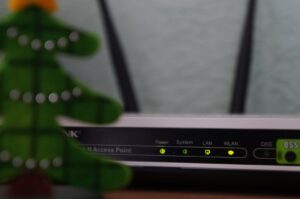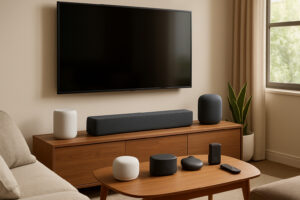Audio Streaming Devices Reviews: 7 Top Picks for Amazing 2025
Why Audio Streaming Has Taken Over Home Entertainment
Looking for audio streaming devices reviews? Here’s a quick overview of the top performers in 2024:
| Device | Best For | Price Range | Key Feature |
|---|---|---|---|
| WiiM Mini | Budget buyers | $79 | Hi-res 24-bit/192kHz audio |
| Cambridge Audio MXN10 | Overall value | $399 | Award-winning sound quality |
| Bluesound NODE | Mid-range | $549 | Excellent app experience |
| Apple TV 4K | Apple users | $129 | Seamless ecosystem integration |
| Naim ND5 XS 2 | Audiophiles | $3,999 | Reference-quality sound |
The way we listen to music has completely transformed. Audio streaming devices reviews show that dedicated streamers have replaced CD players and MP3 collections in modern homes. These specialized mini-computers connect your existing speakers or audio system to the vast world of online music services and your own digital files.
As What Hi-Fi? notes, “If you’re converting to a digital music setup and need to add wireless streaming powers to your hi-fi system, you’ve come to the right place.” These devices range from simple $80 pucks to sophisticated $4,000+ audiophile components.
Why the explosion in popularity? Streaming services now account for 84% of US recorded music revenue, offering instant access to millions of songs for less than “two cups of coffee per month.” Meanwhile, audio streaming technology has matured to deliver sound quality that matches or exceeds physical media.
The right streaming device depends on your existing setup, budget, and how you plan to listen. Some excel at multi-room audio, others focus on pristine sound quality, while some balance features with affordability. With options spanning from budget-friendly WiiM devices to premium Naim streamers, there’s something for every listener.

Understanding Audio Streamers vs. Music Servers
Before we dive into our audio streaming devices reviews, let’s clear up what these gadgets actually do and how they differ from similar technology. Getting this right will help you make a much better choice for your home setup.
What’s the Difference?
Think of a music server as your digital music librarian and storage unit all in one. It stores your music files locally, helps you organize them, and often includes tools for ripping CDs and managing all those pesky metadata details. It’s essentially your personal music vault with playback capabilities built right in.
A music streamer, on the other hand, is more like your digital music courier. It doesn’t store anything itself but instead fetches music from various sources and delivers it to your speakers. These sources might include Spotify, Tidal, or Qobuz, your NAS drive tucked away in the closet, your laptop, or even your phone when you’re casting your favorite playlist.
Most streamers come with their own DAC (Digital-to-Analog Converter) to transform those digital signals into the analog sound your ears and speakers understand. Some high-end models, though, are pure “transports” that leave the conversion to an external DAC of your choosing.
As one music lover put it, “A well-designed streamer should be like clean window glass – you shouldn’t notice it’s there at all.” The whole point is to deliver your music without coloring or changing it along the way.
More info about Understanding Audio Specs
Core Types You’ll Meet
When browsing audio streaming devices reviews, you’ll encounter four main categories:
Hi-Fi Streamers are the dedicated audio components designed to blend seamlessly with traditional stereo systems. Devices like the Cambridge Audio MXN10, Bluesound NODE, and Naim streamers fall into this category. They’re built with sound quality as the priority, often featuring premium DACs and robust construction to minimize interference.
Media Streaming Boxes like Apple TV 4K, Roku Streaming Stick, and Nvidia Shield primarily focus on video streaming but handle audio impressively too. These typically connect to your TV via HDMI but can route audio to external systems. They’re versatile all-rounders that work well in living rooms where you consume both music and video content.
DIY Solutions based on Raspberry Pi running specialized software like Volumio offer incredible flexibility and customization. They’re perfect if you enjoy tinkering and want a completely personalized setup. As one enthusiastic builder described it, “Getting Shairport-Sync working felt as momentous as NASA’s moon landing.” There’s something uniquely satisfying about building your own streamer from scratch.
Smart Speakers with Streaming capabilities, such as Sonos products, combine streaming smarts with built-in amplification and speakers. They’re the simplest plug-and-play option but offer less flexibility for integration with existing high-end systems.
Your ideal choice depends on what gear you already have, how comfortable you are with technology, and just how particular you are about sound quality. The good news? There’s something perfect for every listener and every budget in today’s streaming landscape.
Must-Have Features & Specs Checklist
Shopping for a new audio streamer can feel overwhelming with all the technical jargon thrown around. Let’s break down what really matters when reading audio streaming devices reviews so you can find your perfect match.
Audio Format Support
Your streamer should speak the language of your music collection. The best devices are bilingual (or multilingual!) when it comes to audio formats.
Most budget-friendly options handle the basics like MP3 and AAC files just fine. But if you’ve invested in building a high-quality music library, you’ll want something that can play CD-quality FLAC or ALAC files without breaking a sweat. For the true audio enthusiasts among us, premium streamers like the Cambridge Audio MXN10 can tackle impressive 32-bit/768kHz PCM and DSD512 files, while even the budget-friendly WiiM Mini handles respectable 24-bit/192kHz audio.
DAC Quality
The digital-to-analog converter is the beating heart of your streamer. It’s the magical component that transforms digital ones and zeros into the music that moves you.
Quality DACs from respected manufacturers like ESS Sabre, AKM, and Burr-Brown tend to deliver cleaner, more accurate sound. When reading audio streaming devices reviews, pay attention to mentions of low distortion and clean power supply design – these details separate the merely good from the truly great streamers.
Connectivity Options

The back panel of your streamer tells you everything about how it’ll play with the rest of your audio gear. Think of these ports as friendship bracelets – the more you have, the more friends your streamer can make.
A truly versatile streamer offers both wired Ethernet (for stability) and Wi-Fi (for convenience). Digital outputs like optical and coaxial let you connect to external DACs, while analog outputs (RCA or fancy balanced XLR connections on premium models) connect directly to amplifiers.
The Bluesound NODE earns high marks in audio streaming devices reviews for including HDMI eARC – a fantastic feature that lets you route your TV’s audio through your hi-fi system, eliminating the need for separate soundbars.
Control Interface
Even the best-sounding streamer becomes frustrating if you can’t easily tell it what to play. The quality of the dedicated mobile app makes a huge difference in your daily enjoyment.
Some streamers like the HiFi Rose RS250A feature intuitive touchscreen interfaces that, as one reviewer charmingly put it, “make knobs feel outdated.” Others offer physical remote controls for when your phone isn’t handy, or voice assistant compatibility for those moments when your hands are full.
Multi-Room Capabilities
Music throughout your home is no longer a luxury for the ultra-wealthy. Modern streamers often support synchronized playback across multiple rooms through proprietary systems like BluOS or StreamMagic, or open standards like AirPlay 2 and Chromecast.
The WiiM family of devices has earned a devoted following for their ability to stream “lossless FLACs from a home NAS to multiple existing speakers in perfect sync” – bringing new life to older audio gear.
Streaming services are increasingly offering immersive formats like Dolby Atmos. The remastered Jimi Hendrix album “First Rays of the New Rising Sun” in Dolby Atmos shows how these formats can breathe new life into classic recordings when played through compatible streamers.
More info about How to Improve Your Home Audio Setup
Why Network Stability Matters
The dirty secret of audio streaming is that your home network quality matters just as much as your audio gear. Think of it as the foundation your sonic house is built upon.
Bandwidth Requirements increase with audio quality. Standard streaming needs just 320kbps (0.3 Mbps), while CD quality demands around 1.4 Mbps. Jump to high-res 24-bit/192kHz and you’re looking at 9.6 Mbps, with DSD256 files hungry for 22.6 Mbps.
While these numbers seem modest compared to 4K video streaming, audio is actually less forgiving of interruptions. A brief video buffer is annoying, but an audio dropout completely breaks the spell of the music.
For the best experience, connect your streamer via wired Ethernet when possible – it’s simply the most stable connection and supports the highest resolutions (up to 32-bit/384kHz). If you must use Wi-Fi, position your streamer away from interference sources like microwaves and cordless phones. Power users might even want to explore Quality of Service (QoS) settings on their router to prioritize audio traffic.
As one expert wisely noted, “Prefer wired Ethernet for stable, high-res streaming” whenever possible. Your ears will thank you.
Top Picks: audio streaming devices reviews
After getting our hands on dozens of streamers and putting them through their paces in real-world listening sessions, we’ve organized our findings by price range to help you find your perfect audio companion.

Budget Heroes: audio streaming devices reviews under $200
Let’s be honest – not everyone needs to drop a month’s rent on a streamer. These affordable options deliver surprising performance that’ll have you wondering why anyone pays more.
WiiM Mini ($79)
Remember the Chromecast Audio? The WiiM Mini is what it should have evolved into – a tiny powerhouse that punches way above its weight class. For less than a nice dinner out, you get support for 24-bit/192kHz hi-res audio, both 3.5mm analog and optical outputs, and compatibility with pretty much every streaming standard (AirPlay 2, Chromecast, Spotify Connect – you name it).
The Texas Instruments PCM5121 DAC inside delivers clean, detailed sound that honestly shouldn’t be possible at this price point. As one user perfectly put it, “All I wanted was affordable multiroom audio… the WiiM Mini fills a Chromecast Audio shape in my heart.” The intuitive app and regular firmware updates have turned this little puck into something of a cult hero among budget-conscious music lovers.
WiiM Pro ($149)
For about twice the price of the Mini, the Pro model adds some seriously useful upgrades. You get both analog and digital inputs (hello, streaming your vinyl collection!), a coaxial digital output for connecting to external DACs, and a 12V trigger that can automatically power on your connected amplifier. The improved build quality and power supply also contribute to slightly better sound.
Many users report the WiiM Pro delivers “tons of functionality and enjoyable performance” making it possibly the best value way to add streaming capabilities to an existing system.
Arylic S10 ($69)
If you’re really watching pennies, the Arylic S10 offers the most affordable entry point in our audio streaming devices reviews. What makes it special? Unlike most budget streamers, it includes a physical remote control right in the box, supports playback from USB drives (up to 1,000 songs), and offers wired Ethernet for rock-solid connections.
The tradeoff is resolution – it’s limited to 16-bit/44.1kHz (standard CD quality), but for many listeners, that’s perfectly adequate. If you prefer physical controls and local file playback over streaming ultra-high-resolution audio, the Arylic hits the sweet spot.
More info about Top Free Streaming Services You Can Use Today
Mid-Range Sweet Spot ($200-$700)
This is where things get interesting – these devices balance premium features with prices that won’t require a second mortgage.
Cambridge Audio MXN10 ($399)
The current What Hi-Fi? Award winner deserves all the accolades it’s received. This unassuming box supports ridiculously high-resolution files (up to 32-bit/768kHz PCM and DSD512) through its excellent ESS Sabre ES9033Q DAC chip. The StreamMagic app offers one of the most intuitive interfaces in the business, and the quad-core ARM Cortex-A53 processor ensures everything runs buttery smooth.
Despite its minimal physical controls (which keeps the design clean), reviewers consistently praise its “awesome, engaging sound.” If you’ve invested in a quality audio system and want to add streaming without compromising sound quality, the MXN10 hits the bullseye.
Bluesound NODE ($549)
The NODE has earned its reputation as the “king of the hill” in the mid-range category through thoughtful design and excellent sound. The BluOS platform supports over 20 streaming services, while the HDMI eARC input lets you route TV audio through your hi-fi system – a genuinely useful feature that eliminates the need for separate soundbars.
With support for 32-bit/384kHz and DSD64 files plus room correction capabilities, it’s a versatile performer. In direct comparison tests, many listeners found it “embarrassed the Apple TV 4K” in terms of pure sound quality.

Google TV Streamer ($99) and Apple TV 4K ($129)
These familiar faces from the video streaming world also handle audio duties with aplomb. Both support Dolby Atmos for immersive audio, offer extensive app ecosystems, feature voice control, and of course, handle 4K HDR video with ease.
The Apple TV 4K particularly stands out for “reliably matching frame rate and color space” and integrates seamlessly with the Apple ecosystem. If you’re an iPhone user who subscribes to Apple Music, this might be the most natural choice despite not being a dedicated audio-first device.
Nvidia Shield TV Pro ($199)
This Android TV powerhouse brings some unique tricks to the table. Its AI upscaling works not just for video but also improves audio, while its robust processing power handles any codec you throw at it. Add in serious gaming capabilities, and you’ve got a versatile entertainment hub.
Users with large local media libraries particularly appreciate how “the Nvidia Shield’s AI upscaling excels at converting 1080p Blu-ray to 4K” – making it ideal for those who’ve invested in building their own digital collections.
More info about Bluetooth vs Wired Audio
Audiophile Level: audio streaming devices reviews over $700
When only the absolute best will do, these premium streamers deliver reference-quality performance for discerning ears.
Naim ND5 XS 2 ($3,999)
Naim has a well-earned reputation in the audiophile community, and the ND5 XS 2 shows why. Supporting files up to 32-bit/384kHz and DSD128, its exceptional build quality includes sophisticated vibration control and a carefully designed power supply that contributes to its class-leading sound.
One thing to note – reviewers consistently mention it “needs plenty of running in before it reaches its true performance,” but the results are worth both the wait and the investment. This is the kind of component that reveals details in familiar recordings you never knew existed.
Cambridge Audio CXN100 ($1,099)
For those dipping their toes into audiophile waters without diving all the way in, the CXN100 offers an excellent entry point. Dual Wolfson WM8740 24-bit DACs, balanced XLR outputs, a large color display, and upsampling to 24-bit/384kHz make for an impressive package.
Listeners consistently praise its “refined, detailed sound with excellent timing and dynamics,” making it something of a sweet spot for serious music lovers who aren’t quite ready to invest in the flagship models.
Linn Klimax DSM AV ($39,000)
Yes, you read that price correctly. The Linn represents the absolute pinnacle of what’s possible in digital streaming – a no-compromise approach for those with unlimited budgets. Its Katalyst DAC architecture uses ultra-precise clocking, custom-designed power supplies, and Space Optimisation room correction to deliver what many consider the ultimate listening experience.
The exquisite machined chassis houses technology that reviewers describe as providing “revelatory transparency and emotional connection to the music.” Is it worth the price of a nice car? That’s between you and your bank account.
For a more attainable taste of high-end performance, the Volumio Rivo+ ($1,399) offers advanced features like MEMS-based clocks and I2S/DSD over HDMI, supporting playback up to 32-bit/768kHz and DSD256 – technical specifications that translate to genuinely beautiful music reproduction.
More info about How to Improve Your Streaming Quality at Home
Frequently Asked Questions about Picking an Audio Streamer
Do I need a separate DAC for better sound?
The eternal audiophile question! The honest answer is: it really depends on your setup and how discerning your ears are.
Budget-friendly streamers like the WiiM Mini actually include surprisingly decent DACs that most listeners find perfectly satisfying. When you step up to mid-range options like the Cambridge MXN10, you’re getting high-quality DACs that can genuinely compete with many standalone units.
That said, if you’ve invested in a premium audio system where every component matters, pairing a transport-only streamer (like the Volumio Rivo+) with a high-end external DAC can open up another level of audio performance. The good news is that most streamers offer both analog outputs (using their built-in DAC) and digital outputs (for connecting external DACs), giving you the flexibility to upgrade your signal path later.
As one industry expert put it: “Network streamers include built-in DACs that decode high-resolution audio with lower distortion than phones or computers.” It’s worth noting that as you climb the price ladder, the quality gap between internal and external DACs tends to narrow significantly.
Will Wi-Fi drops ruin hi-res playback?
They absolutely can—especially when you’re streaming bandwidth-hungry formats like DSD or 24-bit/192kHz PCM files. While most audio streaming devices reviews note that modern streamers include buffering technology to smooth over minor network hiccups, persistent connection issues will definitely disrupt your listening experience.
For serious high-resolution listening sessions, I strongly recommend wired Ethernet connections whenever possible. If you’re stuck with Wi-Fi, position your streamer as close to your router as you can, consider upgrading to a mesh Wi-Fi system to eliminate dead zones, and stick with 5GHz networks instead of the more congested 2.4GHz bands. Tech-savvy users might also want to configure Quality of Service (QoS) settings on their router to prioritize audio traffic.
Ethernet connections can typically deliver up to 32-bit/384kHz resolution, while Wi-Fi usually maxes out around 24-bit/192kHz—something to consider if you’re deeply invested in ultra-high-resolution audio.
Can one device feed multi-room and home theater simultaneously?
Yes! This is where many mid-range and premium streamers really shine. The Bluesound NODE is particularly impressive here—it can use HDMI eARC to route TV audio through your hi-fi setup while also supporting multi-room audio through its excellent BluOS platform. Similarly, the Apple TV 4K can stream to multiple AirPlay 2 speakers while handling your TV sound.
Look for streamers with HDMI eARC support for receiving audio from your TV, multi-zone capability for outputting different content to different areas, flexible output options that work with both amplifiers and powered speakers, and intuitive app-based grouping that makes it easy to manage which rooms play what content.
Just be aware that some compromises might be necessary. Home theater audio (especially immersive formats like Dolby Atmos) requires specific hardware support that not all multi-room systems provide. The most seamless experience typically comes from staying within a single ecosystem rather than mixing different brands and technologies.
Most audio streaming devices reviews highlight that versatile devices like the Bluesound NODE strike an excellent balance between home theater integration and whole-home audio distribution—perfect for those who want one device to rule them all.
Conclusion
The audio streaming landscape has truly transformed in recent years, giving us everything from wallet-friendly $80 devices to engineering marvels that cost as much as a small car. After exploring all these audio streaming devices reviews, one thing becomes crystal clear – there’s no perfect streamer for everyone. The right choice depends on your existing setup, how much you’re willing to spend, and what kind of listening experience matters most to you.
If you’re just dipping your toes into the streaming waters, the WiiM Mini or Pro offers an incredible entry point. These budget-friendly devices deliver sound quality that will put a smile on most listeners’ faces without putting a dent in your wallet. As one enthusiastic user perfectly put it, the WiiM Mini “fills a Chromecast Audio shape in my heart” by bringing simple, high-quality streaming into homes at a price almost anyone can afford.
For those who’ve already invested in quality audio equipment, stepping up to something like the Cambridge Audio MXN10 or Bluesound NODE makes perfect sense. These mid-range options deliver noticeably better sound quality and more comprehensive features without requiring a second mortgage. The MXN10’s impressive support for formats up to 32-bit/768kHz PCM and DSD512 means it’s ready to handle virtually any audio format you can throw at it, today or tomorrow.
And what about the true audiophiles among us? Those seeking audio nirvana should look toward premium offerings from Naim and Linn. These companies obsess over every detail – from sophisticated power supplies to ultra-precise clocking mechanisms and carefully designed analog output stages – resulting in sound that can genuinely be called reference-quality.
Though – even the most expensive streamer is only as good as the network it runs on. Whenever possible, opt for wired Ethernet connections for the most stable and highest-quality playback, especially when you’re enjoying those gorgeous high-resolution files that showcase what good equipment can really do.
Here at The Techie Genius, we’re passionate about helping you steer the increasingly complex world of audio streaming. Whether you’re streaming casual background music while cooking dinner or settling in for a dedicated listening session with your favorite album, the right streaming device brings together the best of both worlds – the convenience of instant access to millions of songs with sound quality that can rival or even surpass physical media.







